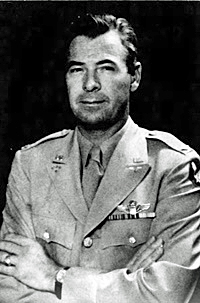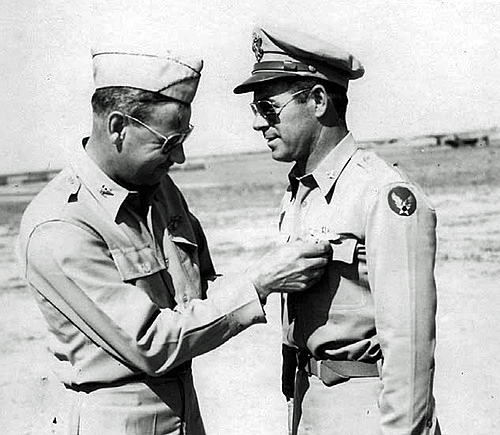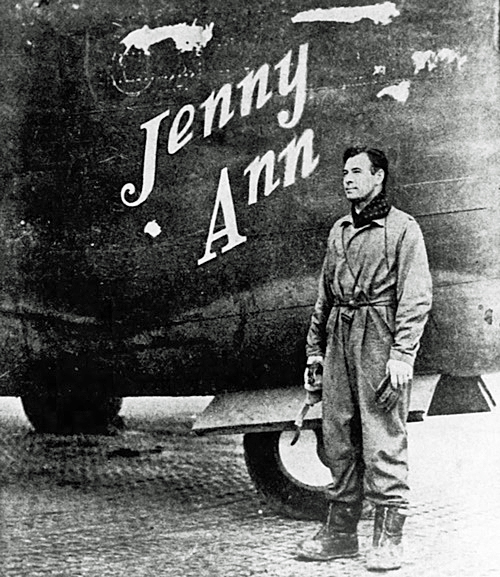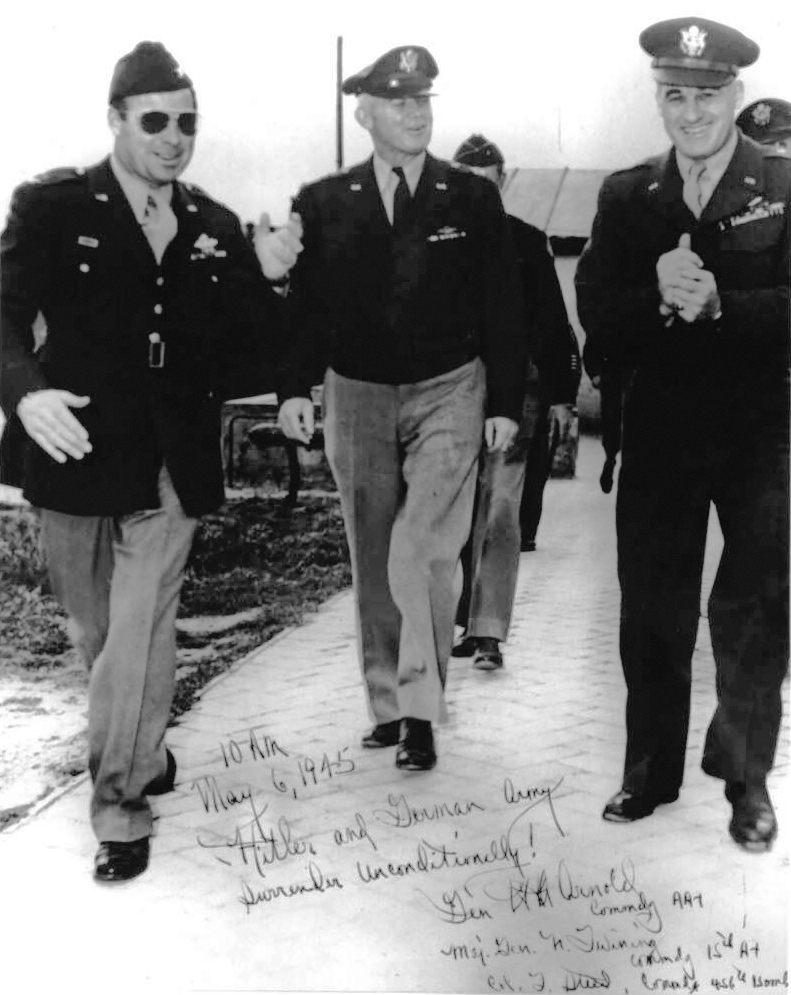Dedication
This website is dedicated to Thomas Webster Steed

1904-1973, Colonel, USAF
Commanding Officer, 456th Bombardment Grooup (H), July 1943 - July 1945
"He is bred of the easy grace of the Old South. His vital wit, his amiable disposition, and his smile which is of the eyes rather than the lips, these are the core of his being; the very essence of the man himself."

Col. Thomas Steed, Commander of the 456th BG, receiving the DFC from Col. Fay R. Upthegrove, Commander of the 304th BW.
Such was the description of Thomas Webster Steed by his peers in the 1928 West Point Howitzer, as he and his classmates prepared for their graduation into the second lieutenant ranks of the United States Army.
Fifteen years later as he took command of the newly activated 456th Bombardment Group (H) that easy grace and amiable disposition was still evident in the now Colonel Steed, but overlaid with a confidence born of years of training in every aspect of the Army Air Corps business. And those "eyes with a smile" could turn blazing black, much to the discomfort of those responsible. By now his youthful characteristics had combined with a hard-earned professionalism to produce that special essence of leadership which won him the admiration and confidence of all ranks of the 456th as he led them to an outstanding record in World War II.
Thomas Webster Steed was born at Mineral Bluff, Georgia, in the Chattahoochee National Forest just below the Tennessee-North Carolina border, on October 18, 1904. His father later moved the family across the Tennessee line to Etowah at the edge of the Cherokee National Forest. Here he was educated in the public schools and then attended Tennessee Military Academy and the University of Tennessee.
He entered the U.S. Military Academy in 1923 on a senatorial appointment and soon found himself nicknamed "Sadie" and "Red" in addition to the more formal sobriquet of Tom.
Apparently the "easy grace of the Old South" or possibly his efforts on the goat football team overcame his recognized capacity for academic work that fall of 1923 for, in Academy parlance, Tom was "found" academically and spent January to August 1924 away from the ramparts of West Point. Part of that time he worked as a "sandhog" in the building of NYC's East River Tunnel.
The 1928 Howitzer subtly explains his being "found" as follows: "Full of the idioms of the Old South, Tom found difficulty in acquainting himself with the more stringent dictums of speech which our course in English demanded. Those expressions, so resonant and soothing to the ear, go unquestioned by the listener; but when translated to the black and white of the written manuscript, the charm and romance are lost; and the faults stand out bare as the stage stripped of its scenery. As a result, Tom was lost to the Class of 1927 but persevered in his effort and passed all barriers with the Class of 1928."
After going through the primary and advanced flying schools at Brooks and Kelly Fields, Texas, 2nd Lt. Steed was assigned to the 99th Observation Squadron at Mitchel Field, New York in April, 1930. Here, in addition to the limited flying time available, he began the then normal apprenticeship in "additional duties" as mess and armament officer and squadron adjutant, as well as attending the school for baker and cooks at Fort Slocum, New York, for one month. As with most officers trained prior to WWII, these additional duties, which went with every reassignment, gave Lt. Steed such detailed experience in all aspects of the Air Corps that he instinctively knew when some WWII type was trying to "snow" him and could quickly turn the snow job into a most embarrassing incident for the other person.
In January 1933, Lt. Steed departed for a three-year tour at Clark Field in the Philippines. Assigned to the 3rd Pursuit Squadron, he led the leisurely post life of those days in the islands, trying to get in as much flying time as allowed, and performed still more additional duties, this time in the transportation and post utilities fields. There were some notable exceptions to the routine, however. In 1934 he flew one of the two U.S. escort planes for the first non-stop flight from Tokyo to Manila; and that October was promoted to first lieutenant. While at Clark Field he also was a member of an airfield survey in Borneo and is thought to have attended a Chinese language school in Shanghai.
First Lieutenant Steed reported to the 19th Bombardment Group at March Field, California in May 1936 and spent the next six years there with the 32nd and 93rd Bombardment Squadrons and the 38th Reconnaissance Squadron. During his March Field tour he was promoted to captain (June 1938), major (February 1941), lieutenant colonel (January 1942), and to colonel (March 1942).
Probably his most memorable experiences on this tour was participating in the first flight of B-17s from Hamilton Field, California, to Hickam Field, Hawaii, in May 1941, for which he received his first Distinguished Flying Cross. As prelude to this event, then Captain Steed attended the Air Corps Tactical School at Maxwell Field, Alabama in 1939 and had also won his spurs as a flight commander.
In August 1942, Colonel Steed left March Field for San Francisco and Headquarters, 4th Bomber Command, where he served as chief of staff until the following summer when he left to take command of the 456th Bomb Group.
When Colonel Steed took command of the 456th at Gowen Field, Boise, Idaho on July 14, 1943 it had an original cadre of 66 officers, 237 enlisted men and no aircraft. When it began moving overseas from Muroc Field (Now Edwards AFB), California, in December 1943, it had 2,300 officers and men and 62 new B-24 Liberators - and a five month history of three changes of station with the ultimate result of having to crowd three months' final training into a little over one month at Muroc.
Colonel Steed labored with the few old aircraft given the group and with the few experienced crews to provide round-the-clock training, but was unable to secure equipment for the high altitude flying and gunnery which obviously were necessary to prepare the crews for combat. When the POM (Preparation for Overseas Movement) inspectors came to that final and biggest question, "Is your group ready for combat?" Colonel Steed replied that, as a professional airman, he could not certify the 456th as ready for combat. He added that he knew the group would go anyway, that the men wanted to get on with the show, and that the 456th would "fight one hell of a war."
Telephones rang all that night as successive higher headquarters, including the Pentagon, tried to get Colonel Steed to change his official statement. But in the end, his position as a professional airman held, and he proceeded to move the group overseas and into combat. To those who observed the POM inspection playlet in person, it was a stark example of how the true professional can separate the wheat from the chaff and get on with the job.
Colonel Steed's "Flying Colts" flew their first combat mission on February 10, 1944 from their base at Stornarella, just south of Foggia, Italy - as a unit of the 304th Bomb Wing Headquartered at Cerignola. When the war ended in May 1945, the 456th had flown over 200 missions, clobbered over 100 targets in 11 different countries, hitting key rail centers, oil fields and refineries, aircraft factories, airfields and troop concentrations. Its last mission was a "first" for the Fifteenth Air Force, the 100% bombing of the Tarvisio Motor Transport Depot in northern Italy. During this group achievement, Colonel Steed's men had earned one Distinguished Service Cross, 19 Silver Stars, 215 Distinguished Flying Crosses, over 2,000 Air Medals; and the 456th had been awarded two Distinguished Unit Citations (for clobbering aircraft factories at Wiener-Neustadt, Austria, on May 10, 1944; and for "taking care of" the oil refineries at Budapest, Hungary, on July 2, 1944) and had earned seven campaign streamers.

Colonel Thomas W. Steed
In leading his "Colts" to such a record, Colonel Steed was awarded the Silver Star, two more Distinguished Flying Crosses, seven Air Medals, and three Commendation Medals. He already had the Legion of Merit for his work as chief of staff of the 4th Bomber Command in 1942-43. His Silver Star was awarded for gallantry in action as leader of the 304th Wing mission to clobber motor works at Munich, Germany. His two WWII Distinguished Flying Crosses were won in leading missions such as the one to the Ploesti oil fields in May 1944.

May 6th, 1945: Germany Surrenders, and Col. Steed (left) is in a jovial mood with Gen Henry "Hap" Arnold (center) and Gen. Nathan Twining.
Colonel Steed returned to the ZI in the summer of 1945, temporarily commanded Marianna Air Base in Florida, then went north as senior instructor for the Massachusetts Air National Guard from April 1946 to August 1948; then to Maxwell AFB, Alabama, as a student in the 1948-49 Air War College class.
During 1949-50 he was commander of the 91st Strategic Reconnaissance Wing and then commander, 4th Air Division, SAC, at Barksdale AFB, Louisiana. He then joined Tactical Air Command as commander of the wing and base at Moses Lake AFB, Washington, and then commanded at Hamilton AFB, California, from where he was retired on October 31, 1952.
Colonel Steed's retirement was for physical reasons stemming from an incident during a training flight in England where he had taken the 91st Strat Recon Wing on TDY in 1950. An airman went berserk during the flight and flailed around with a wrench as flight deck personnel tried to subdue him. During the melee he struck Colonel Steed on the head with the wrench, causing a bone splinter problem which lead to his early retirement and premature death.
Upon his retirement, Colonel and Mrs. Steed returned to the lakeshore home which they had bought at Little Isle Pond, Pelham, New Hampshire, during his tour with the Massachusetts ANG. Here he threw his enthusiasm and energy into becoming a contract realtor and as an appraiser for the Veterans' Administration, as well as enjoying the semi-retired life in this rural cross-roads village area, including cruising the six-acre Little Isle Pond in his homemade houseboat with friends and neighbors.
Colonel Steed died October 21, 1973 at the Veterans Hospital in Manchester, New Hampshire at age 69, with the cause listed as meningioma (tumor arising from the membranes covering the brain). Surviving Colonel Steed are his wife, Julia, whom he met as an Army nurse captain with the 34th Field Hospital at Cerignola, Italy; and a daughter Julia Mary (Mrs. Michael Mawson) of Pond Road, Portsmouth, New Hampshire.
Colonel Steed's wife, Julia, passed away February 26, 1994.
.jpg)
